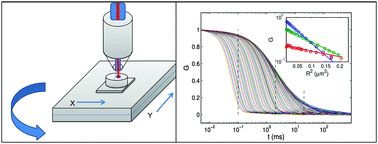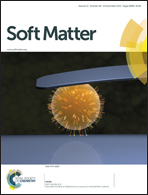Scanning fluorescence correlation spectroscopy as a versatile tool to measure static and dynamic properties of soft matter systems
Abstract
We present the formalism and experimental implementation of scanning fluorescence correlation spectroscopy (SFCS) for the measurements of soft matter system structure and dynamics. We relate the SFCS function Fourier transform to the system intermediate scattering function and demonstrate how SFCS can be combined with specific labelling to measure the desired statistical and kinetic features of the system. Using DNA as a model polymer, we demonstrate the application of SFCS to measure (1) the static structure factor of the system, (2) polymer end-to-end distance distribution, and (3) polymer segmental dynamics in dilute and in dense solutions. The measured DNA end-to-end distance distributions are close to Gaussian. Implementing SFCS we obtain reliable data on segmental mean-square displacement kinetics in dense solutions, where the static FCS approach fails because of dye photobleaching. For moderate concentrations in the semidilute regime (at ∼7 overlap concentrations) segmental dynamics exhibit only weak entanglements. Both of these experimental findings are consistent with theoretical predictions of the weakness of excluded interactions in semiflexible polymers.


 Please wait while we load your content...
Please wait while we load your content...